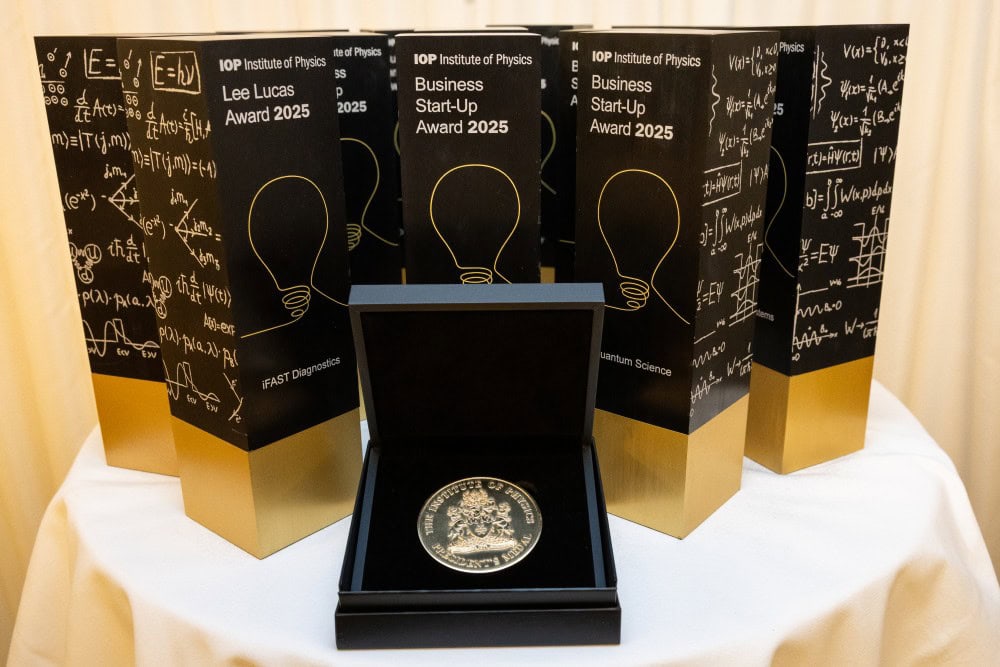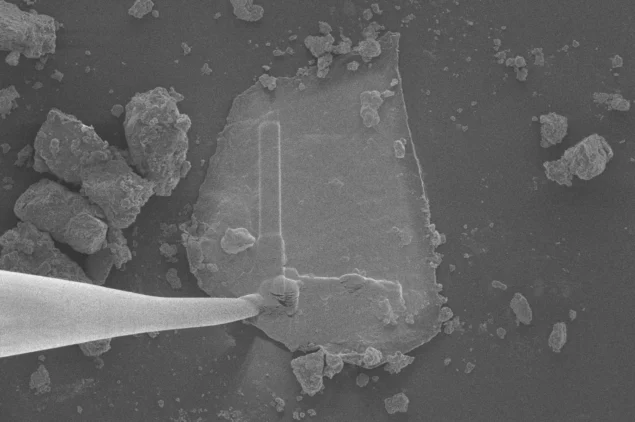Google Data Centers Are Returning Nuclear Power to Tornado Country








Intuitive Machines will work with Telespazio on their planned lunar satellite networks to ensure interoperability and improve performance.
The post Intuitive Machines and Telespazio to collaborate on lunar satellite networks appeared first on SpaceNews.



China is building towards a debut Long March 10 rocket launch in what will be a major test for the country’s crewed lunar landing plans.
The post China plans 2026 debut of new rocket for crewed lunar and LEO missions appeared first on SpaceNews.

The initiative aims to educate policy makers on space as a warfighting domain
The post Space Force Association unveils virtual ‘National Spacepower Center’ for education and wargaming appeared first on SpaceNews.

The Oct. 23 announcement that Airbus, Thales and Leonardo will merge their satellite operations was a historic development for the European space industry. The plan aims to establish a new combined entity by 2027. Historically, the European space industry has been a competent but fragmented market in the form of national champions and competing initiatives. […]
The post The European space industry’s big merger: lessons for emerging space nations appeared first on SpaceNews.

NASA has selected a heliophysics mission to move into the next phase of development amid broader concerns about the state of the field.
The post NASA advances heliophysics mission into next phase appeared first on SpaceNews.
A total of 14 physics-based firms in sectors from quantum and energy to healthcare and aerospace have won 2025 Business Awards from the Institute of Physics (IOP), which publishes Physics World. The awards were presented at a reception in the Palace of Westminster yesterday attended by senior parliamentarians and policymakers as well as investors, funders and industry leaders.
The IOP Business Awards, which have been running since 2012, recognise the role that physics and physicists play in the economy, creating jobs and growth “by powering innovation to meet the challenges facing us today, ranging from climate change to better healthcare and food production”. More than 100 firms have now won Business Awards, with around 90% of those companies still commercially active.
The parliamentary event honouring the 2025 winners were hosted by Dave Robertson, the Labour MP for Lichfield, who spent 10 years as a physics teacher in Birmingham before working for teaching unions. There was also a speech from Baron Sharma, who studied applied physics before moving into finance and later becoming a Conservative MP, Cabinet minister and president of the COP-26 climate summit.
Seven firms were awarded 2025 IOP Business Innovation Awards, which recognize companies that have “delivered significant economic and/or societal impact through the application of physics”. They include Oxford-based Tokamak Energy, which has developed “compact, powerful, robust, quench-resilient” high-temperature superconducting magnets for commercial fusion energy and for propulsion systems, accelerators and scientific instruments.

Oxford Instruments was honoured for developing a novel analytical technique for scanning electron microscopes, enabling new capabilities and accelerating time to results by at least an order of magnitude. Ionoptika, meanwhile, was recognized for developing Q-One, which is a new generation of focused ion-beam instrumentation, providing single atom through to high-dose nanoscale advanced materials engineering for photonic and quantum technologies.
The other four winners were: electronics firm FlexEnable for their organic transistor materials; Lynkeos Technology for the development of muonography in the nuclear industry; the renewable energy company Sunamp for their thermal storage system; and the defence and security giant Thales UK for the development of a solid-state laser for laser rangefinders.
Six other companies have won an IOP Start-up Award, which celebrates young companies “with a great business idea founded on a physics invention, with the potential for business growth and significant societal impact”. They include Astron Systems for developing “long-lifetime turbomachinery to enable multi-reuse small rocket engines and bring about fully reusable small launch vehicles”, along with MirZyme Therapeutics for “pioneering diagnostics and therapeutics to eliminate preeclampsia and transform maternal health”.
The other four winners were: Celtic Terahertz Technology for a metamaterial filter technology; Nellie Technologies for a algae-based carbon removal technology; Quantum Science for their development of short-wave infrared quantum dot technology; and Wayland Additive for the development and commercialisation of charge-neutralised electron beam metal additive manufacturing.
James McKenzie, a former vice-president for business at the IOP, who was involved in judging the awards, says that all awardees are “worthy winners”. “It’s the passion, skill and enthusiasm that always impresses me,” McKenzie told Physics World.
iFAST Diagnostics were also awarded the IOP Lee Lucas Award that recognises early-stage companies taking innovative products into the medical and healthcare sector. The firm, which was spun out of the University of Southampton, develops blood tests that can test the treatment of bacterial infections in a matter of hours rather than days. They are expecting to have approval for testing next year.
“Especially inspiring was the team behind iFAST,” adds McKenzie, “who developed a method to test very rapid tests cutting time from 48 hours to three hours, so patients can be given the right antibiotics.”
“The award-winning businesses are all outstanding examples of what can be achieved when we build upon the strengths we have, and drive innovation off the back of our world-leading discovery science,” noted Tom Grinyer, IOP chief executive officer. “In the coming years, physics will continue to shape our lives, and we have some great strengths to build upon here in the UK, not only in specific sectors such as quantum, semiconductors and the green economy, but in our strong academic research and innovation base, our growing pipeline of spin-out and early-stage companies, our international collaborations and our growing venture capital community.”
For the full list of winners, see here.
The post Institute of Physics celebrates 2025 Business Award winners at parliamentary event appeared first on Physics World.

Paris, France [December 12, 2025] – Novaspace’s 6th Ground Segment Market Prospects report projects a $106 Billion market and a fundamental shift in satellite infrastructure economics. NGSO constellations are reshaping […]
The post $106B Ground Segment Market Enters Service‑Driven Era appeared first on SpaceNews.
More molecules and compounds vital to the origin of life have been detected in asteroid samples delivered to Earth by NASA’s OSIRIS-REx mission. The discovery strengthens the case that not only did life’s building blocks originate in space, but that the ingredients of RNA, and perhaps RNA itself, were brought to our planet by asteroids.
Two new papers in Nature Geoscience and Nature Astronomy describe the discovery of the sugars ribose and glucose in the 120 g of samples returned from the near-Earth asteroid 101955 Bennu, as well as an unusual carbonaceous “gum” that holds important compounds for life. The findings complement the earlier discovery of amino acids and the nucleobases of RNA and DNA in the Bennu samples.
A third new paper, in Nature Astronomy, addresses the abundance of pre-solar grains, which is dust that originated from before the birth of our Solar System, such as dust from supernovae. Scientists led by Ann Nguyen of NASA’s Johnson Space Center found six times more dust direct from supernova explosions than is found, on average, in meteorites and other sampled asteroids. This could suggest differences in the concentration of different pre-solar dust grains in the disc of gas and dust that formed the Solar System.
It’s the discovery of organic materials useful for life that steals the headlines, though. For example, the discovery of the space gum, which is essentially a hodgepodge chain of polymers, represents something never found in space before.
Scott Sandford of NASA’s Ames Research Center, co-lead author of the Nature Astronomy paper describing the gum discovery, tells Physics World: “The material we see in our samples is a bit of a molecular jumble. It’s carbonaceous, but much richer in nitrogen and, to a lesser extent, oxygen, than most of the organic compounds found in extraterrestrial materials.”
Sandford refers to the material as gum because of its pliability, bending and dimpling when pressure is applied, rather like chewing gum. And while much of its chemical functionality is replicated in similar materials on our planet, “I doubt it matches exactly with anything seen on Earth,” he says.
Initially, Sandford found the gum using an infrared microscope, nicknaming the dust grains containing the gum “Lasagna” and “Neapolitan” because the grains are layered. To extract them from the rock in the sample, Sandford went to Zack Gainsforth of the University of California, Berkeley, who specializes in analysing and extracting materials from samples like this.
Having welded a tungsten needle to the Neapolitan sample in order to lift it, the pair quickly realised that the grain was very delicate.
“When we tried to lift the sample it began to deform,” Gainsforth says. “Scott and I practically jumped out of our chairs and brainstormed what to do. After some discussion, we decided that we should add straps to give it enough mechanical rigidity to survive the lift.”

By straps, Gainsforth is referring to micro-scale platinum scaffolding applied to the grain to reinforce its structure while they cut it away with an ion beam. Platinum is often used as a radiation shield to protect samples from an ion beam, “but how we used it was anything but standard,” says Gainsforth. “Scott and I made an on-the-fly decision to reinforce the samples based on how they were reacting to our machinations.”
With the sample extracted and reinforced, they used the ion beam cutter to shave it down until it was a thousand times thinner than a human hair, at which point it could be studied by electron microscopy and X-ray spectrometry. “It was a joy to watch Zack ‘micro-manipulate’ [the sample],” says Sandford.
The nitrogen in the gum was found to be in nitrogen heterocycles, which are the building blocks of nucleobases in DNA and RNA. This brings us to the other new discovery, reported in Nature Geoscience, of the sugars ribose and glucose in the Bennu samples, by a team led by Yoshihiro Furukawa of Tohoku University in Japan.
Glucose is the primary source of energy for life, while ribose is a key component of the sugar-phosphate backbone that connects the information-carrying nucleobases in RNA molecules. Furthermore, the discovery of ribose now means that everything required to assemble RNA molecules is present in the Bennu sample.
Notable by its absence, however, was deoxyribose, which is ribose minus one oxygen atom. Deoxyribose in DNA performs the same job as ribose in RNA, and Furukawa believes that its absence supports a popular hypothesis about the origin of life on Earth called RNA world. This describes how the first life could have used RNA instead of DNA to carry genetic information, catalyse biochemical reactions and self-replicate.
Intriguingly, the presence of all RNA’s ingredients on Bennu raises the possibility that RNA could have formed in space before being brought to Earth.
“Formation of RNA from its building blocks requires a dehydration reaction, which we can expect to have occurred both in ancient Bennu and on primordial Earth,” Furukawa tells Physics World.
However, RNA would be very hard to detect because of its expected low abundance in the samples, making identifying it very difficult. So until there’s information to the contrary, “the present finding means that the ingredients of RNA were delivered from space to the Earth,” says Furukawa.
Nevertheless, these discoveries are major milestones in the quest of astrobiologists and space chemists to understand the origin of life on Earth. Thanks to Bennu and the asteroid 162173 Ryugu, from which a sample was returned by the Japanese Aerospace Exploration Agency (JAXA) mission Hayabusa2, scientists are increasingly confident that the building blocks of life on Earth came from space.
The post Components of RNA among life’s building blocks found in NASA asteroid sample appeared first on Physics World.

The “leftover” gamma radiation produced when the beam of an electron accelerator strikes its target is usually discarded. Now, however, physicists have found a new use for it: generating radioactive isotopes for diagnosing and treating cancer. The technique, which piggybacks on an already-running experiment, uses bremsstrahlung from an accelerator facility to trigger nuclear reactions in a layer of zinc foil. The products of these reactions include copper isotopes that are hard to make using conventional techniques, meaning that the technique could reduce their costs and expand access to treatments.
Radioactive nuclides are commonly used to treat cancer, and so-called theranostic pairs are especially promising. These pairs occur when one isotope of an element provides diagnostic imaging while another delivers therapeutic radiation – a combination that enables precision tumour targeting to improve treatment outcomes.
One such pair is 64Cu and 67Cu: the former emits positrons that can identify tumours in PET scans while the latter produces beta particles that can destroy cancerous cells. They also have a further clinical advantage in that copper binds to antibodies and other biomolecules, allowing the isotopes to be delivered directly into cells. Indeed, these isotopes have already been used to treat cancer in mice, and early clinical studies in humans are underway.
Researchers led by Mamad Eslami of the University of York, UK have now put forward a new way to make both isotopes. Their method exploits the fact that gamma rays generated by the intense electron beams in particle accelerator experiments interact only weakly with matter (relative to electrons or neutrons, at least). This means that many of them pass right through their primary target and into a beam dump. These “wasted” photons still carry enough energy to drive further nuclear reactions, though, and Eslami and colleagues realized that they could be harnessed to produce 64Cu and 67Cu.
Eslami and colleagues tested their idea at the Mainz Microtron, an electron accelerator at Johannes Gutenberg University Mainz in Germany. “We wanted to see whether GeV-scale bremsstrahlung, already available at the electron accelerator, could be used in a truly parasitic configuration,” Eslami says. The real test, he adds, was whether they could produce 67Cu alongside the primary experiment, which was using the same electron beam and photon field to study hadron physics, without disturbing it or degrading the beam conditions.
The answer turned out to be “yes”. What’s more, the researchers found that their approach could produce enough 67Cu for medical applications in about five days – roughly equal to the time required for a nuclear reactor to produce the equivalent amount of another important medical radionuclide, lutetium-177.
“Our results indicate that, under suitable conditions, high-energy electron and photon facilities that were originally built for nuclear or particle physics experiments could also be used to produce 67Cu and other useful radionuclides,” Eslami tells Physics World. In practice, however, Eslami adds that this will be only realistic at sites with a strong, well-characterized bremsstrahlung fields. High-power multi-GeV electron facilities such as the planned Electron-Ion Collider at Brookhaven National Laboratory in the US, or a high-repetition laser-plasma electron source, are two possibilities.
Even with this restriction, team member Mikhail Bashkanov is excited about the advantages. “If we could do away with the necessity of using nuclear reactors to produce medical isotopes and solely generate them with high-energy photon beams from laser-plasma accelerators, we could significantly improve nuclear medicine treatments and reduce their costs,” Bashkanov says.
The researchers, who detail their work in Physical Review C, now plan to test their method at other electron accelerators, especially those with higher beam power and GeV-scale beams, to quantify the 67Cu yields they can expect to achieve in realistic target and beam-dump configurations. In parallel, Eslami adds, they want to explore parasitic operation at emerging laser-plasma-driven electron sources that are being developed for muon tomography. They would also like to link their irradiation studies to target design, radiochemistry and timing constraints to see whether the method can deliver clinically useful activities of 67Cu and other useful isotopes in a reliable and cost-effective way.
The post Leftover gamma rays produce medically important radioisotopes appeared first on Physics World.

China launched new Guowang satellite internet payloads Dec. 11 as preparations advanced for a Long March 12A orbital launch and first stage landing attempt.
The post China launches new Guowang satellites, Long March 12A launch and landing attempt date set appeared first on SpaceNews.

The head of NASA’s astrophysics division offered an upbeat assessment of upcoming missions, a stark contrast to the bleak outlook in the agency’s budget proposal six months ago.
The post NASA astrophysics director offers optimistic vision despite budget uncertainty appeared first on SpaceNews.